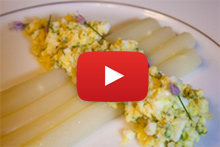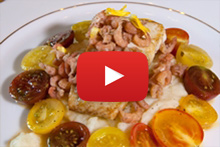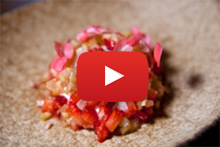
Chef Dries Molkens - BELGIUM
Three brothers live with their parents, not far from the city of Mons in Belgium, in a somewhat unusual farm. Indeed, in addition to agriculture and the breeding of pigs, sheep, cows and chickens, they brew beer and run a little tavern. It is open for business every Friday and Saturday, and they serve their own beer and some home-cooked food. People from all over the place come to enjoy the local meals, beverages and unique atmosphere. The little restaurant was created in an old barn and the decor is characteristically rustic: long wooden tables with benches, decorated with vases filled with stem wheat. Old bottles with candles give a warm yellow light to the room. They serve different beers, from blonde, brown, amber, and malted to bitter ones. The food, prepared by their mother, contains only fresh ingredients from the farm like Carbonade Flamande, Lapin a la bière (rabbit cooked with beer), Chicons a la béchamel (Endives with Béchamel sauce), Choux de Bruxelles au grattons de porc (Brussel sprouts with pork bacon), and of course, the famous Frites or French fries. A place like this is usually called an "estaminet." Today, the name estaminet refers to taverns, inns and breweries typical of the North, where décor consists of old utensils and typical, austere and traditional decorations, while serving regional dishes and drinks.
In terms of origination, "French fries" are actually "Belgium fries." In fact, it is in the 16th century where one finds traces of the first cut potatoes deep fried in boiling oil. American President, Thomas Jefferson, because he liked the fries prepared by his French cook, conveniently declared them as "French fries." It is said that Jefferson, President of the United States from 1801 until 1809, and also ambassador to France from 1785 to 1789, introduced the fries to the United States in 1802, as a recipe from his French chef, Honoré Julien. Jefferson referred to fried potato strips as "frying potatoes in the French manner." This is one of the earliest references to fries being referred to as "French." But before that, in the region of Meuse Valley, frying fish was quite common. Although, during the winter, the rivers froze very fast and fishing was extremely difficult. So, rather than frying fish during these coldest of times when the fish could not be accessed; as an alternative, they would cut up potatoes in long thin slices and fry them instead. Perhaps the people of the Meuse Valley are the true trailblazers.
If Belgians have a reputation for being warm and welcoming, their cuisine certainly mirrors this, albeit with a hint of gourmet. It is a nation of fries, beer and chocolate, and so many other delights. The most famous meal in Belgium might be "les Moules Frites," mussels with fries. It is a dish that is very simple to prepare and served in every dining establishment in the country, as well as the steak frites. But the variety of the cuisine is expansive. Le "Waterzooi," is a fish or meat dish simmered extensively in a vegetable broth before adding cream. La "Carbonade Flamande," is similar to a beef bourguignon where the wine is replaced with brown beer. In this dish, the meat is slowly simmered in sugar-beer before being served with chips or mashed potatoes. The Boulet à la Liegeoise also known as "Boulet sauce Lapin," does not include rabbit, and even so, it is still a very famous meal within the region of Liège in Belgium. It is composed of one or two large meatballs and served with a thick sauce (based on Liège syrup, shallots and sage), fries, and a salad or applesauce. There are a lot of other noteworthy specialties as well, including, the "stoemp," the "salade liégeoise," the "fricadelle," the "gauffre" or waffle, and the "speculoos." In particular, one dish has a strange name: the "Filet Americain" that would translate to the American Filet. A Belgian explorer who set out to conquer the American West in the 19th century found himself lost in the desert. He survived by eating pieces of his horse mixed with morsels of cactus. Later, Joseph Niels, a Brussels chef, developed this unique entrée in honor of the explorer. However, he replaced horsemeat with beef and the cactus with capers. The dish is thickened with an egg yolk, mayonnaise and Worcestershire sauce. The American fillet is more or less the Belgian version of the tartare steak.
As France has the cooking, Argentina the Tango and China with Yueju opera, in 2016 UNESCO inscribed Belgian beer on their list of the intangible cultural heritage of humanity. The country is home to nearly 1600 different varieties of beer divided into four kinds, according to their process of production. The first one is refined by using a system of low fermentation. Through the brewing process, this type of ale has less alcohol (less than 1.5%) and tends to be lighter in color—such as a Pilsner or Pils. The most famous brand internationally is Stella Artois. The second lager is that which is fermented to an excessive degree. These beers are higher in alcohol and richer in color; whereas in contrast, the white ones are mostly based on wheat malt. Also, worth noting, are the Stouts and the Porters, these beers are much darker and thicker. The India Pale Ale (IPA) does have a pale color, though it is most noted for its hoppy and rather bitter taste—it is brewed from hops rather than malt to give it its distinctive taste. Some of the most famous IPAs would be: the Trapiste, Chimay, Orval, Abbey, and the Dobbelen IPA Tripel.
The third form of fermentation is one that is spontaneous. These Lambic beverages are typically from Belgium, with a very specific sour, but sometimes-sweet taste. This kind of distillation is carried out by employing wild yeasts present in the air in the vicinity of Brussels and in the valley of the Senne. This particular process takes between 3 to 6 months and is referred to as "young," conversely from 2 to 3 years is considered "mature." There are four categories of beers derived from Lambics: "Gueuze," "Kriek," "Raspberry," and "Faro." The most well-known are the "Mort subite," "Belle Vue," "Cantillon," "Saint Louis," "Girardin," "Oud Beersel," and "3 Fonteinen." The Brewery Rodenbach started this last technique more than a century ago. They use a mixture of roasted nuts, adding several varieties of yeasts as well as a culture of lactic bacilli. The concoction is then stored in oak barrels for a minimum of one and a half years. Then, it is mixed with a young, high fermented beer.
With a regional beer, why not a piece of chocolate? Chocolate is also a much-loved, iconic product of Belgium. The supreme privilege for a chocolate maker is to become a patented supplier for the court. A real entitlement, because this appellation is given by His Majesty the King and this establishes a sincere proof of trust. There are four patented suppliers to the court: Galler, Godiva, Côte-d’Or and Mary. The "Chocolatier" is given the respect and responsibility that the position implies and the constant concern of improvement in all the domains affecting the company. They meet as part of an association to continually defend their title and to emphasize what it represents in terms of quality, trust, and worthiness to their customers.
A Belgian consumes on average 8 kilos of chocolate per person, per year while the production is upwards of 650,000 tons annually, with the majority destined for exportation. Their main competitor, and another great nation of this delectable confection, Switzerland, produces about 183,738 tons per year. Manufacturing excellent chocolate is one symbol of Belgian quality acknowledged around the world. The country has more than 500 chocolate makers and around 2000 chocolate shops—one for every 5,500 people.
In particular, the Belgian praline is a most notable delight. Jean Neuhaus Junior invented it. The Neuhaus Company was created in 1857, by his grandfather, in association with his brother-in-law, a pharmacist. The impetus for the praline stemmed from an idea to coat pills with chocolate in order to make taste and absorption less disagreeable to the patient. In 1912, Neuhaus Junior created the first filled chocolate and the praline was born. There are pralines filled with cream, butter cream, ganache, praline paste, liqueur and coffee as well as with pieces of fresh or dried fruit, and caramel. It was Neuhaus’ wife, Louise Agostini, who invented an innovative way to sell pralines: in a "ballotin" or small cardboard box.
In Belgium, one can start studying in any discipline they wish to at the inception of high school. The executive chef of the Belgium Embassy in Washington, D.C., Dries Molkens, did not plan on becoming a chef; rather, he began his education in high school studying economics. After a few years, he realized economics was not a good fit and decided to try out culinary school while attending high school. So, at the age of 15, he started his culinary journey at the "Stella Maris Hotel School." Turns out, it was a great fit. Soon after, he was invited to attend the best culinary school in the country: the "Hotel School Ter Duinen, " situated in the north of Belgium, in the town of Coxyde, close to the French border. This school has 4 restaurants: 3 open to the public and 1 for the students. But, Chef Molkens wanted more, so he began working during the weekends at the famous restaurant, "De Eiken," an establishment operated by one of the best chefs in the country, Jean-Marie Smets, along with his wife. He also worked for a catering company and learned how to prepare for and service large events. Chef Molkens has also worked for prestigious restaurants such as "Fornuis" in Antwerp, the "Eyckerhof" in Boenem, and the "Het Gebaar" in Antwaert. The aforementioned establishments have one Michelin star and are top noted in the Gault & Millau guide.
In Washington, D.C., groups of chefs always work in unison when they have significantly large events, both literally and figuratively. Jens Fisker, the chef of the Danish residence shared with me that Dries Molken was "the best of all of them" and at only 23-years-old, "he has a bright future ahead of him!"
Here is the menu that he exclusively prepared for Diplomatic Connections: "Asperges à la flamandand" and "Asperges mousseline met westmalle Beer," and then, flounder with Grey North sea shrimp along with buttermilk whipped potatoes and summer tomatoes. To finish, we enjoyed a delicious "Strawberry tartare with yogurt espuma and rhubarb."
Bon appetit! Guten Appetit! Eet smakelijk!
 Asperges mousseline met westmalle Beer |
 Flounder with Grey North sea shrimp |
 Strawberry tartare |
Download Recipes |
- Apartments, Housing, and Real Estate
- Automotive Sales & Leasing - Cars, SUVs & Trucks
- Clothing & Apparel
- Communications & Technology
- Concierge Services
- Contracting
- Dining & Entertainment
- Education
- Event Planning Services
- Financial Services
- Health & Beauty
- Home Furnishings
- Hotels & Accommodations
- Insurance
- Medical & Dental Services
- Office Services
- Property Management
- Security Services
- Shipping & Moving Services
- Specialty Services
- Travel & Transportation









